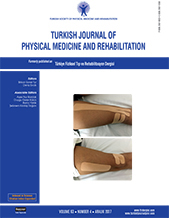Relationship between obesity and musculoskeletal system finding among children and adolescents
2 Department of Family Medicine, Medical Faculty of Marmara University, İstanbul, Turkey
3 Department of Physical Medicine and Rehabilitation, Dr. Lütfi Kırdar Kartal Training and Research Hospital, İstanbul, Turkey
4 Department of Physical Medicine and Rehabilitation, Medical Faculty of Marmara University, İstanbul, Turkey DOI : 10.5606/tftrd.2017.422 Objectives: This study aims to demonstrate the relationship between obesity and musculoskeletal system examination findings and functionality among 5-16 years old population-based sample.
Patients and methods: This is a cross-sectional field study. Sample of this study was selected from 4,246 participants of a study, which assessed the prevalence of obesity among school children aged between 6-15 in Pendik, Istanbul, in 2013-2014 school year. Physical examination included inspection, gait, balance, muscle strength and range of motion (ROM) assessment. Turkish version of Pediatric Outcomes Data Collection Instrument (PODCI) was used. Physical examination findings and PODCI scores of “normal weight” and “overweight/obese” groups were compared. Correlation between body mass index (BMI), ROM and PODCI subscale scores were also evaluated.
Results: A total of 318 children were included in the study. 39.3% (n=125) were normal weight, 61.7% (n=193) were overweight/obese. Pes planus was the most common musculoskeletal problem with a rate of 23.9%. We found that pes planus was more common (p=0.000), standing time on one leg was shorter (p=0.002), time to complete timed up and go test (TUG) was longer (p=0.004) and “happiness” subscale scores of PODCI were lower (p=0.000) in overweight/obese children compared to their normal weight peers. Range of motion values were decreased, especially on the lower limbs, in overweight/obese children (p<0.05) compared to normal weight children. Body mass index values showed a negative correlation with ROM and PODCI “happiness” subscale scores (p<0.05).
Conclusion: Musculoskeletal problems are more common in overweight/obese children than in their normal weight peers. Increase in BMI correlates with decrease in balance, emotional functionality and ROM values. It may be possible to protect overweight/obese children from serious musculoskeletal disorders by interventions that reduce BMI.
Keywords : Balance; childhood; functionality; musculoskeletal; obesity

















